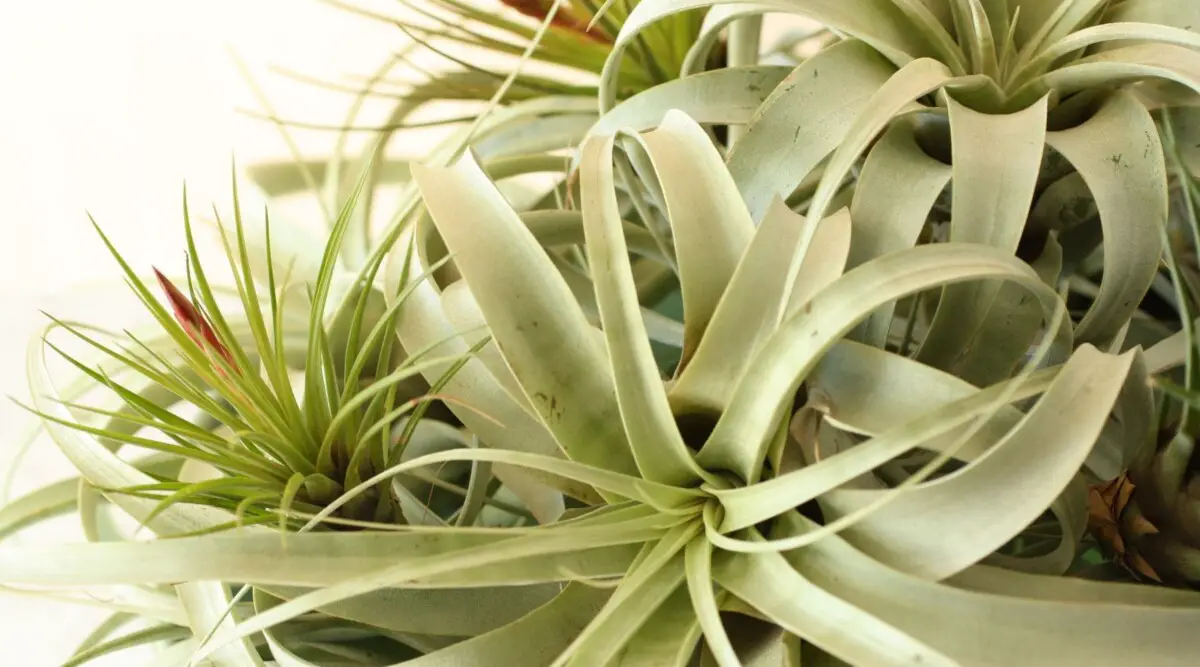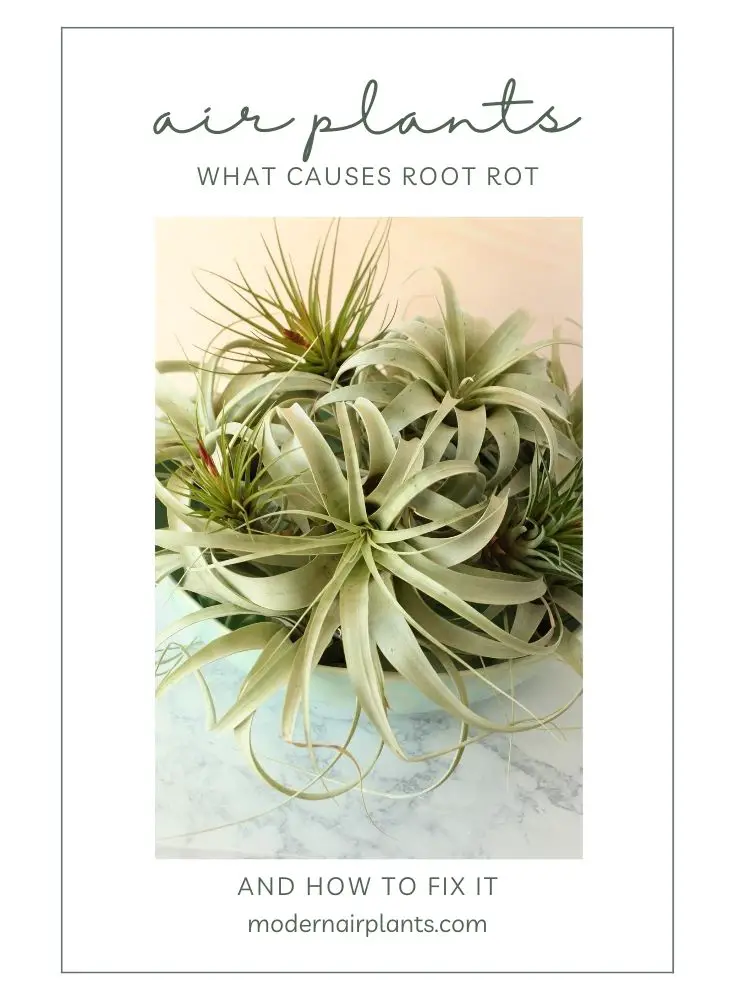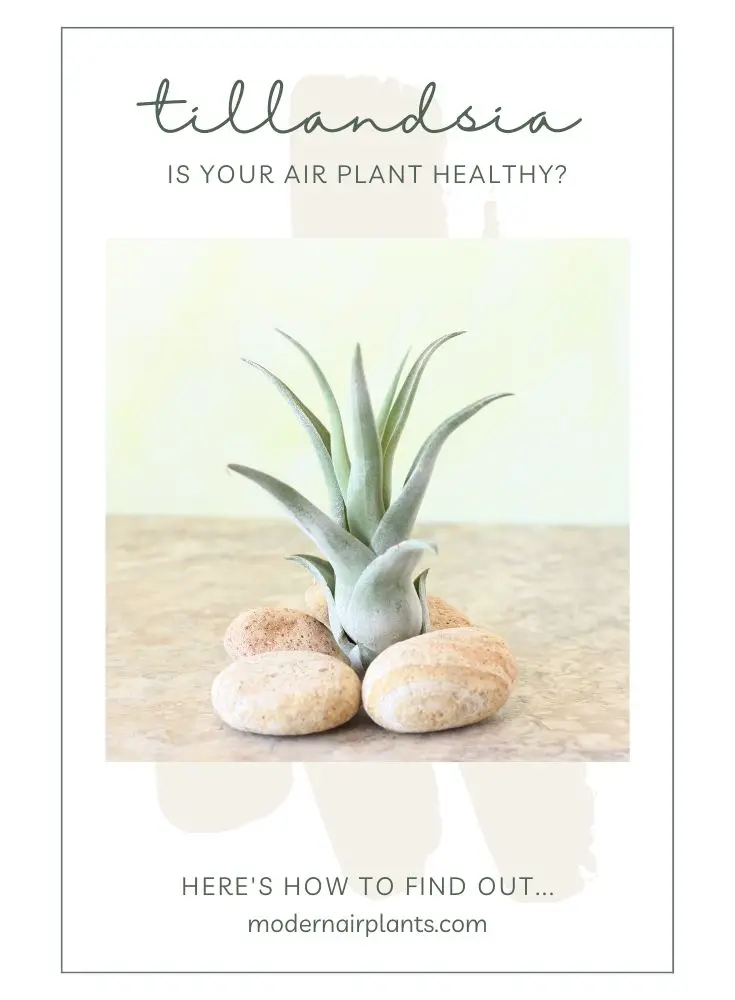
Air Plant Rot: What Causes It and How You Can Fix It

Although air plants are pretty low-maintenance creatures that require minimal care, they can quickly begin to rot if you don’t take care of their essential needs.
This post may contain affiliate links, and I love all the products I promote.
Rotting air plants can have several reasons. Overwatering is the most probable one, which can cause wet rot. Lack of air circulation will promote dry rot. Improper lighting and inadequate temperatures, toxins, and incorrect use of fertilizers also cause rotting. Pest infection can be a reason, too.
In this article, you’ll find out the different reasons why air plants rot. You also learn about various air plant diseases and how to deal with them.
What You Need To Know About Air Plants
Air plants are epiphytes, meaning they use their roots to attach themselves to other plants, tree branches, trunks, rocks, and cliffs. They’re non-parasitic, which means they don’t use up the host plant’s food and resources. Their roots are non-functional, and they get what they need from their surrounding air.
Air plants have pores or scales on their leaves, allowing them to absorb all the essential nutrients from the air and moisture. That’s why they don’t need soil to grow. Instead, they need air, along with proper water and light. These plants come in two main varieties:
- Mesic: These air plants mostly come from damp and shaded rain forests, where there’s always plenty of fog, moisture, and rain. However, the dense trees don’t let the direct sunlight hit the air plants, so they’re prone to drying out. You can identify them by their smooth and shiny leaves that range in bright colors from light to dark green.
- Xeric: Xeric species have fuzzy and dusty leaves with white and gray colors. They live in drier areas where it rains less often. When it does, the air plants store water through their leaves and use it up in prolonged droughts. They can tolerate plenty of sunlight.
Signs of Sick and Rotting Air Plants
In most plants, rotting begins at the roots, which are underground. The rotting progresses beneath the surface, where it stays hidden in the first stages. You’ll see the rot when it spreads to the stem and bottom leaves. The rotten roots won’t absorb nutrients and water anymore, and the base will give out.
Because air plants don’t have root systems and they’re above ground, the rotting process takes a different turn.
Air plants may suffer from internal or external rot. If the plant develops brown or black wet spots on its leaves or the base turns dark, it’s rotting externally. If you don’t notice it in the early stages, the rot will spread to the inner parts, and your plant will eventually fall apart.
Sometimes, everything seems fine with your air plant until one day it suddenly wears out and breaks apart. In this case, your air plant has been the victim of internal rot.
Here are the signs of a rotting air plant:
- The green leaves will lose their color and become yellow.
- The base and bottom leaves turn dark.
- Dark spots appear on the leaves.
- The plant becomes soft and squishy.
- The roots will feel mushy.
- The leaves fall off.
- The center of the plant may come out.
- The whole plant falls apart.
Overwatered Air Plant Rot
Overwatering air plants is the most probable cause of rotting. There are three ways to water air plants: misting, dunking, and submerging.
Misting is when you use a spray bottle to wet the air plant thoroughly. To dunk air plants, either put them under running water or place them in a bowl of water and take them out immediately. Submersion is when you give the plants a longer bath by keeping them inside a water container for 10–30 minutes.
Mesic varieties need more water, so submerging them once or twice a week can’t hurt them. They can also be misted and dunked every two or three days. However, Xeric species shouldn’t be left in water for long because they don’t need much water. They prefer to be misted every couple of days. They can go for up to two weeks without water. Submerging air plants for too long can cause rotting.
These rules aren’t for every situation. The watering schedule can vary based on humidity and temperature. For example, you should water air plants more often in hot and dry weather.
The important thing is to listen to your air plant’s body language! When the air plant is thirsty, the leaves will curl toward the center. It may also appear wrinkly.
If you put the wet plant in a closed environment or let it sit on a moist surface like moss, you’ll give fungi a chance to start growing. The same can happen for bulbous air plants or ones with deep pockets at their leaves’ base, where water can collect.
Rotting is the result of a fungal infection. There are two forms of fungus: yeasts and molds. Yeasts will cause the leaves to turn yellow. The surface on which moss grows begins to turn dark and slimy and finally decomposes.
No matter how you water your air plant, you should shake it to get rid of the excess water and then either hang it upside down or put it on a towel until it’s fully dry. If it’s still moist after four hours, use a fan to dry it.
Make sure the plant isn’t wet during the night. Air plants breathe at night by opening up their spores and taking in CO2, which will then be converted into malic acid. They close their spores during the day and use up the acid for photosynthesis. If they can’t absorb CO2, they can’t make the acid and won’t have fuel for the day. This ripple effect will cause the plant to rot slowly.
Other Causes for Air Plant Rot
Lack of Air Circulation
Too much or too little water or sunlight can bring issues for different types of air plants, but there will never be such a thing as “too much air.”
Improper air circulation and poor ventilation will cause “dry rot” in air plants. Lack of airflow will stop air plants from getting their needed nutrients from air particles, and they’ll suffer from dry rot.
This problem occurs when you put air plants in closed terrariums or holders. If you stick the base of an air plant inside a pot, urchin, or any tight container that doesn’t allow proper airflow, the dry rotting will start from that spot and spread to other parts.
Proper ventilation will help with maintaining temperature and humidity. Small rooms, closed terrariums, or tight places don’t make appropriate homes for air plants. They create a damp and moist environment inside. The air plant never gets a chance to dry off completely, which will promote wet rot.
If this is the case for you, relocate the air plant to an open area. Turn on the air conditioning system or fans. You can even use desk fans or small USB fans to promote the airflow around your air plants.
Improper Lighting
All air plants need a sufficient amount of indirect daily light to thrive. Unlike Mesic varieties, Xeric air plants can tolerate a few hours of direct sunlight. However, air plants can’t thrive in dark places. They’ll start to rot if they stay in dimly lit areas for too long.
At least six hours of daily indirect sunlight is essential for all air plants. You can put them within 1–3 feet of east, west, or south-facing windows. If your house doesn’t get that much light, install an artificial lighting system within 1–2 feet of the air plant.
Improper Temperature
Most air plants come from warm areas, whether dry or humid. They can’t tolerate cold temperatures, especially below 40° F (5° C). If they experience the slightest frost, they’ll become prone to rotting.
A few air plant species like the Tillandsia usneoides have evolved to thrive in freezing temperatures, but that doesn’t apply to all air plants.
For most air plants, especially commercial ones, the ideal temperature range is between the 60s and the 80s. You shouldn’t place them near air conditioning vents or close to windows during winters. If you keep your plants outside and the temperature drops during the winter where you live, bring them in.
Ensure they’re dry before the weather gets cold at night because the moisture on their leaves can become too cold and result in rotting.
Toxins
Harmful chemicals in water, food, or the environment can also cause rotting:
- Soft water: Most water softening systems replace calcium and magnesium ions with sodium chloride. These salts aren’t harmful to us but can cause air plants to rot. Air plants don’t have soil for filtering out the salts, so they’ll absorb them through their leaves. The salts will build up at the ends of the leaves and block the pores from absorbing nutrients.
- Copper: Air plants are highly allergic to copper. Check their environment for any copper decorations. The wires you used for securing them in their place may contain copper. Some types of pressure-treated wood include copper. The fertilizer you’re using may have copper inside.
- Zinc and Boron: Most regular plant fertilizers contain these two elements. Check the ingredients before feeding your air plants.
- Smoke: Since the air plants can absorb air molecules through their leaves, they can also absorb smoke particles, which will poison them and cause rotting. Keep your air plants away from all types of smoke.
- Rust: Inspect the containers and decorations that the air plant is in touch with for rust because it can promote rotting.
Fertilizers
Wild air plants don’t need fertilization. However, urban air doesn’t contain all the nutrition they need. You need to use water-soluble fertilizers to keep your air plants lush and help them produce more colorful flowers.
The fertilizer should be free of copper, zinc, and boron. Most fertilizers contain these chemicals because other plants benefit from them, but they’re highly toxic to air plants and can cause rot. Buy bromeliad, orchid, or tillandsia fertilizers.
Also, never over-fertilize your air plant, which could cause fertilizer burn. Dilute the fertilizer according to the instructions with the water you use to mist or submerge the air plant. Fertilizing once a month is more than enough for air plants. Any more than that and you’ll see the leaves turning brown and crispy.
Pests
Pest infection is the least probable reason for your rotting air plant, especially if you keep them inside the house. Three main pest type can attack your air plant and cause rotting:
Mealybugs
If your air plant is infested with mealybugs, you’ll notice a white cotton-like substance covering the leaves. They have small white bodies, without wings. They multiply rapidly and consume the air plant’s juices or sap, causing the leaves to turn pale and yellow and shed.
The female mealybugs lay several eggs on the underside of the leaves. When they hatch, the juveniles start eating the most nutritious parts of the leaf. They migrate to another leaf after the previous one is out of juice.
If you notice a black substance on the plant, it means the mealybugs have attracted ants with the sweet honey-dew they produce.
Scale Insects
The life cycle of scale insects begins with a female insect searching for the most nutritious part of the air plant for laying her eggs. The eggs hatch a couple of weeks later, and all the nymphs attach themselves to the leaves’ underside, using their hard shells.
They resemble tiny bumps and scales on the plant, making them hard to notice. Scale insects begin to feed on the plant’s juices, causing them to turn yellow and rot.
Aphids
Aphids are the most common garden pests, and air plants aren’t immune to them. They’re microscopic with various colors, from light green and yellow to brown. Aphid colonies can slowly eat the air plants until they’re rotten and dead.
Here are the best ways to get rid of bugs and pests affecting your air plants:
- Wash and Clean: First, isolate the infected plant from the other ones. Detach the rotten and infested leaves. Then flush out the insects with running water. You can also submerge the plant to suffocate the insects. Use insecticidal soap or ivory dish soap for cleaning the air plant and getting rid of the pests.
- Ladybugs: Use these natural predators to kill off the pest colonies. Ladybugs aren’t harmful to air plants, and they enjoy eating pests. You can either buy them from stores or try to attract them to your garden. Lure them by growing herbs and flowers like dill, cilantro, fennel, tansy, marigolds, and scented geraniums.
- Culinary Herb Garden: Usually, herbs don’t attract pests because of their natural and strong aroma. Most herbs require the same environment as air plants: bright spots with indirect sunlight. Consider growing an herb garden inside or outside your house near where you keep your air plants.
- Neem Oil: Apply neem oil to the surface of the infected leaves. It’ll slowly poison the pests and help with maintaining their growth.
- All-Natural Insecticides: Natural insecticides like Diatomaceous Earth or DE can help you deter and kill pests without harming yourself or the air plants. It’s a power-like substance you should sprinkle on the plants.
- Alcohol: Soak a cloth or piece of cotton with rubbing alcohol and rub it on the leaves to get rid of the pests.
Watch the infected plant for a couple of weeks to prevent re-infestation before putting it back to its original place.
How To Reverse Air Plant Rot
Pay Attention
By paying attention to the watering schedule, light, air circulation, and fertilizer, you’ll have a healthy and happy air plant. When watering the plant, always inspect it for signs of rotting. The sooner you catch the infection, the easier it’ll be to treat.
Revive the Plant
When you notice rotten parts on your plant, look for signs of pests. If you see any, try to save the plant by deterring the pests using the previous sections’ mentioned methods.
After you’ve ruled out the possibility of pests, quarantine the rotten air plants. As you know, the fungus is the cause of rotting, which can easily transfer to other air plants. Avoid using the same containers for watering the sick and healthy air plants.
Next, gently remove the rotten leaves. If the leaves are on the outside, pull on them and detach them. This way, the air plant will spend all its energy on the remaining leaves. The healthy leaves will get a chance to absorb nutrients from the air and get more sunlight.
If you find out that the central leaves are rotting, removing them may result in the whole plant falling apart.
Relocate the air plant to a well-lit area where there’s proper air circulation. Avoid direct sunlight. Use a fan for drying the air plant if needed.
Withhold watering the plant for a couple of days. You’ll probably notice a big difference. Don’t overwater after you’ve seen an improvement in the plant. Dry the plant as fast as possible.
If the reason for rotting isn’t fertilizer burn, use appropriate fertilizers properly to strengthen your plant.
Don’t give up on your plant before ten days. If you don’t see any improvement, or if you didn’t find green leaves to work with in the first place, bury the plant in a mulch pile.
Use Cinnamon
Cinnamon is a natural fungicide you can use to stop the spreading of the infection. After going through the previous steps, apply cinnamon powder to the affected spots and let the plant dry. Do this every day until the rotting disappears. Because the infection might come back, you can dilute the water with cinnamon essential oil and water the air plant with it.
Other Reasons Your Air Plant Is Looking Sick
Underwatering
Dehydration is the opposite of overwatering but very easy to treat. It also happens to fewer people. Maybe ones who bought air plants as care-free pets! You should realize that air plants do need water when they’re inside the house.
The first sign of a dehydrated air plant is leaves that curl towards the center. The plant will look limp and sick. The leaves will start to look dry, shriveled, and brown, especially the tips.
If you notice any of these signs, trim the brown parts using a shear, and give your air plant a long and nice bath. It could be anywhere from 5 hours to 12 hours long. Submerge it in a bowl of water, large enough to fit the plant easily. Check on the air plant every few hours. If the leaves straighten out again, the plant is likely to pull through. Don’t let the plant get clumpy and over-watered.
You can tie the plant to a stone using a thread to keep it from floating. All the leaves should be completely underwater. It’s also possible to put some weight on the air plant. However, be careful not to hurt the plant or break the leaves.
It’s best to use dechlorinated water for an air plant with brown tips. You can let the water sit out for the night to stabilize before submerging the air plant.
If the air plant looks sick again, give it another bath, but this time let it sit in the water for a shorter period. Repeat until your air plant is looking lush.
Use fertilizers to help your air plant gain its strength and energy.
Remember to shake the excess water off the air plant and let it fully dry before transferring it back to its home.
Heat and Direct Sunlight
If you notice brown or yellow markings on your air plant, it’s probably a sign of sunburn. Xeric leaves have a thin layer of fur, which lets them withstand direct sunlight for short periods. They shouldn’t be cooking in the sun for several hours!
On the other hand, Mesic varieties don’t have protection on their leaves. They’ll dry out and get burnt very soon.
Plus, even the xeric species need to be in an open area to withstand direct sunlight. You should never place a closed container like a terrarium under direct light. They can heat up very fast and damage the air plant. Plus, the glass can act as a magnifier and burn your plant.
Lifespan
The life cycle of an air plant starts as seedlings or pups. They grow slowly at first, but as time passes, they get bigger faster. When they reach full maturity, they start to bloom beautiful flowers.
The next step is producing puppy plants or pups. The pups start to grow from the base of the original plant. Unfortunately, most air plants reach the end of their lives after their pups are grown. The mother plant starts to die slowly. Its leaves will turn brown and shed. You can either detach the pups from the main plant and grow them as separate plants or leave them to grow as a cluster.
Frequently Asked Questions About Rotting Air Plants
What Does an Overwatered Air Plant Look Like?
An overwatered air plant starts to brown. You’ll notice the base of the plant turn dark and slimy. Brown or black spots may form on other parts of the leaves. The bottom leaves will shed one after the other, and the middle part of the plant may come out. Yellowing leaves are typical, and in the last stages, the whole air plant will fall apart.
Can You Save a Dying Air Plant?
You can save a dying air plant depending on its problem and how early you notice it. If your air plant is dying because of thirst, soaking it in water for a couple of hours at a time can revive the plant.
If the air plant is drying up from too much sunlight or suffering in a dimly lit environment, you can heal it by fixing the amount of light it gets. In the case of rotting, you should cut back on watering and dry your plant as soon as you can. If the air plant is infested with pests, flush the insects out using water, and use insecticides if needed.
How Do I Know if My Air Plant Is Healthy?
Your air plant is healthy if it has green and lush leaves. Dark bases, black spots, and brown leaf tips are all signs of sickness. The leaves shouldn’t be yellow, wrinkly, or curled toward the center. If your mature air plant is blooming flowers, you don’t need to worry about it because they only produce flowers when they’re in tip-top conditions.

Conclusion
Taking care of an air plant is easy, but it has its own specific rules. Like any other plant, they can fall victim to special illnesses if you don’t provide them with proper water, air, and light.
Rot is one of the most common air plant diseases, and it can be hard to cure. However, paying attention to these little pieces of nature can help you catch any of the sicknesses at an early stage, making it easier for you to treat.
Buy Air Plants
If you’re like most people, you want to get the most for your money. CLICK HERE, to find out where you can buy healthy air plants that, with proper care, you’ll enjoy for years to come!
Sources
- Garden Therapy: How to Revive a Sick Air Plant
- Modern Air Plants: WHY IS MY AIR PLANT DYING?
- Terrarium Planting Guide: Air Plant Turning Brown, Black or Has Spots? Causes, Tips
- Gardening Know-How: Reviving A Tillandsia Air Plant: Can You Revive An Air Plant.
- Succulents Box: WHAT COULD KILL YOUR AIR PLANT?
- Air Plants Web: Everything About Air Plant Diseases
- Air Plant Shop: WHAT’S KILLING MY AIR PLANTS?
- Just Home Gardening: How to Revive An Air Plant
- Succulents Box: HOW TO SAVE UNDERWATERED AND OVERWATERED AIR PLANTS
- Air Plant Greenhouse: How to revive my air plant?
- Succulent City: Why Do My Air Plants Keep Dying? Everything You Need To Know
- Air Plant Central: Can Air Plants Get Bugs or Ants?
- Gardening Know-How: Why Is My Air Plant Rotting: How To Stop Air Plant Rot

